
វិច្ឆិកា . 16, 2024 16:46 Back to list
methyl hydroxyethyl cellulose
Understanding Methyl Hydroxyethyl Cellulose Structure, Applications, and Benefits
Methyl Hydroxyethyl Cellulose (MHEC) is a cellulose derivative widely used in various industries due to its unique properties. The substance is produced by the chemical modification of natural cellulose fibers, resulting in a semi-synthetic polymer that maintains many of the beneficial features of its natural counterpart. With a combination of methyl and hydroxyethyl groups, MHEC exhibits enhanced solubility and stability, making it an invaluable resource across multiple applications.
Chemical Structure and Properties
MHEC is formed by the etherification of cellulose with methyl and hydroxyethyl groups. The addition of these functional groups modifies the natural structure of cellulose, improving its properties such as solubility in water, viscosity, and film-forming capabilities. MHEC is typically available in a powder form, which is easy to handle and can be dissolved in cold water to create a clear, viscous solution.
The degree of substitution, which indicates the number of hydroxyl groups that have been replaced by methyl or hydroxyethyl groups, plays a crucial role in defining the properties of MHEC. Depending on the application, varying degrees of substitution can be tailored to achieve desired viscosity and solubility characteristics.
Applications
One of the most prominent applications of MHEC is in the construction industry, particularly in cement-based products. MHEC enhances the workability and adhesion of mortars, screeds, and tile adhesives, allowing for improved application and better performance of building materials. Its viscosity-modifying properties help in achieving a smooth consistency, reducing the effort needed to mix and apply these products.
In the personal care and cosmetics sectors, MHEC is employed as a thickener and emulsifier. Its ability to retain moisture and provide a pleasing texture makes it ideal for creams, lotions, and gels. Additionally, MHEC's non-ionic nature allows it to be used in formulations without affecting the stability of active ingredients.
methyl hydroxyethyl cellulose

Pharmaceutical applications of MHEC include its use as a binder and controlled-release agent in tablet formulations. The controlled release is essential for ensuring that active ingredients are delivered in a sustained manner, improving the efficacy of medications.
Furthermore, MHEC is utilized in the food industry as a thickening agent and stabilizer. It can enhance the texture of products like sauces, dressings, and dairy items, providing creaminess without adding fat.
Benefits
One of the primary benefits of MHEC is its safety profile. As a derivative of cellulose, it is non-toxic and biodegradable, making it an environmentally friendly option compared to synthetic additives. This attribute has led to its increasing acceptance in various industries that prioritize sustainability.
Additionally, MHEC is versatile in its applications, and its viscosity can be tailored to meet specific needs, making it a favorite choice among formulators. It is also compatible with a wide range of other ingredients, which allows for creative formulation across different sectors.
MHEC is relatively stable under various conditions, including varying pH levels and temperatures, which makes it reliable for use in diverse environments. This stability extends its shelf life and performance in end products, ensuring consistency and quality.
Conclusion
Methyl Hydroxyethyl Cellulose stands out as a multifunctional polymer with a broad range of applications. From construction to personal care and food industries, its properties facilitate innovation and efficiency in product formulation. As industries move towards more sustainable options, MHEC's natural origins and safety make it a compelling choice for formulators looking to enhance the quality and performance of their products. As research and technology progress, the potential applications of MHEC are likely to expand even further, solidifying its position in the modern-day market.
-
Versatile Hpmc Uses in Different Industries
NewsJun.19,2025
-
Redispersible Powder's Role in Enhancing Durability of Construction Products
NewsJun.19,2025
-
Hydroxyethyl Cellulose Applications Driving Green Industrial Processes
NewsJun.19,2025
-
Exploring Different Redispersible Polymer Powder
NewsJun.19,2025
-
Choosing the Right Mortar Bonding Agent
NewsJun.19,2025
-
Applications and Significance of China Hpmc in Modern Industries
NewsJun.19,2025







